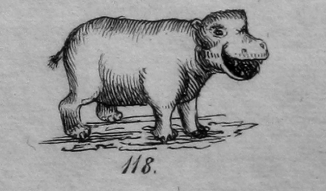
Here’s a humorous, smiling hippopotamus from 1845. I’m not sure, but it might also be winking ;)
Like the unfortunate Dodo bird, the smiling hippo illustrates William Buckland’s Geology and Mineraology in the Bridgewater Treatises (Swedish translation, 10th notebook of the Populär Naturkunnighet series).
Fossils and Victorian trolls
In 1821 some quarry workers in Kirkdale, Yorkshire, stumbled upon a hidden cave filled with fossils. When the word of the discovery reached the geologist William Buckland, he rushed to the site to analyse and document the multitudes of fossilised bones and fragments in the cave.
Surprisingly, the fossil specimens included several bones of not only common but also very un-British animals: tigers, hippos, elephants and rhinos. Heaps upon heaps of hyena bones and petrified feces were also found…a find that would form conclusive evidence for Buckland’s interpretations.
So how had the exotic bones ended up in Yorkshire?
Either the animal carcasses had been washed there by the biblical flood or, as the modern view insisted, the animals had lived in the area long before humans. Buckland’s closer investigation revealed that many of the bones were gnawed and pockmarked as if bitten by small teeth. The marks turned out to be made by hyenas that had inhabited the cave. Buckland proposed that in the cave was a prehistoric hyena’s den where the scavengers had brought bits and pieces of larger animals. Also, the opening of the cave was too small for larger animals to enter.
Different interpretations of the fossil findings in the Kirkdale cave led to a flame war between the modern geologists and those supporting the biblical explanation. Each side attacked the other in provocative articles and sour counter-publications. If you were in any way interested in geology at that time you simply had to choose a side. Although his own analysis eroded the scriptural approach, Buckland himself could not totally leave behind his religious ideals.
The disagreement finally escalated to such violent proportions that these otherwise polished Victorian gentlemen-scientists could not be invited to the same dinners.
Ever argued with creationists on the Internet? The early geologists were already at it in 1844. An anonymous member of the British Association for the Advancement of Science was clearly trolling the scriptural circles with his satirical poem targeting the geologists’ main antagonist William Cockburn, the Dean of York:
His Bible’s defence
shows the Dean’s want of sense
And Buckland and Sedgewick
Have wrapp’d him with hedgestick
And tho’ he supposes
He’s a great friend of Moses
His proceedings appear
To demonstrate clear
That Moses & He
Can never agree
For one was quite silent on things
that he knew not
T’other sticks to his folly
like a fly in a glue pot.
Source of the poem: J. M. I. Klaver, Geology and Religious Sentiment